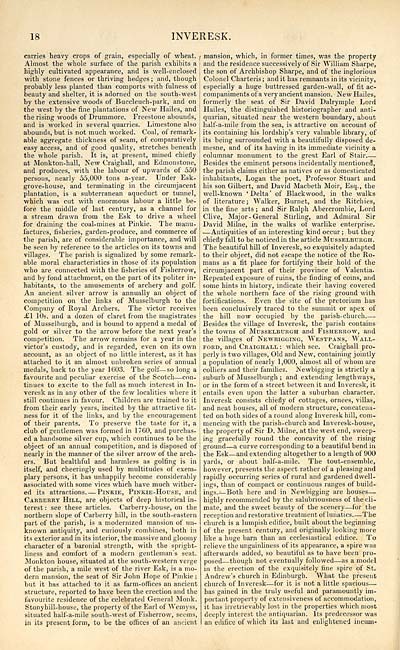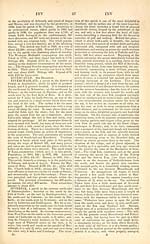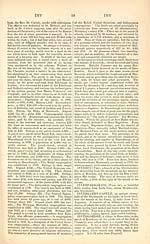Download files
Complete book:
Individual page:
Thumbnail gallery: Grid view | List view

18
INVERESK.
carries heavy crops of grain, especially of wheat.
Almost the whole surface of the parish exhibits a
highly cultivated appearance, and is well-enclosed
with stone fences or thriving hedges; and, though
probably less planted than comports with fulness of
beauty and shelter, it is adorned on the south-west
by the extensive woods of Buccleuch-park, and on
the west by the fine plantations of New Hailes, and
the rising woods of Drummore. Freestone abounds,
and is worked in several quarries. Limestone also
abounds, but is not much worked. Coal, of remark-
able aggregate thickness of seam, of comparatively
easy access, and of good quality, stretches beneath
the whole parish. It is, at present, mined chiefly
at Monkton-hall, New Craighall, and Edmonstone,
and produces, with the labour of upwards of 550
persons, nearly 55,000 tons a-year. Under Esk-
grove-house, and terminating in the circumjacent
plantation, is a subterranean aqueduct or tunnel,
which was cut with enormous labour a little be-
fore the middle of last century, as a channel for
a stream drawn from the Esk to drive a wheel
for draining the coal-mines at Pinkie. The manu-
factures, fisheries, garden-produce, and commerce of
the parish, are of considerable importance, and will
be seen by reference to the articles on its towns and
villages. The parish is signalized by some remark-
able moral characteristics in those of its population
who are connected with the fisheries of Fisherrow,
and by fond attachment, on the part of its politer in-
habitants, to the amusements of archery and golf.
An ancient silver arrow is annually an object of
competition on the links of Musselburgh to the
Company of Royal Archers. The victor receives
£1 10s. and a dozen of claret from the magistrates
of Musselburgh, and is bound to append a medal of
gold or silver to the arrow before the next year's
competition. The arrow remains for a year in the
victor's custody, and is regarded, even on its own
account, as an object of no little interest, as it has
attached to it an almost unbroken series of annual
medals, back to the year 1(303. The golf — so long a
favourite and peculiar exercise of the Scotch — con-
tinues to excite to the full as much interest in In-
veresk as in any other of the few localities where it
still continues in favour. Children are trained to it
from their early years, incited by the attractive fit-
ness for it of the links, and by the encouragement
of their parents. To preserve the taste for it, a
club of gentlemen was formed in 17G0, and purchas-
ed a handsome silver cup, which continues to be the
object of an annual competition, and is disposed of
nearly in the manner of the silver arrow of the arch-
ers. But healthful and harmless as golfing is in
itself, and cheeringly used by multitudes of exem-
plary persons, it has unhappily become considerably
associated with some vices which have much wither-
ed its attractions Pinkie, Pinkie-House, and
Carberry Hill, are objects of deep historical in-
terest : see these articles. Carberry-house, on the
northern slope of Carberry hill, in the south-eastern
part of the parish, is a modernized mansion of un-
known antiquity, and curiously combines, both in
its exterior and in its interior, the massive and gloomy
character of a baronial strength, with the spright-
liness and comfort of a modern gentleman's seat.
Monkton house, situated at the south-western verge
of the parish, a mile west of the river Esk, is a mo-
dern mansion, the seat of Sir John Hope of Pinkie ;
but it has attached to it as farm-offices an ancient
structure, reported to have been the erection and the
favourite residence of the celebrated General Monk.
Stonyhill-house, the property of the Earl of Wemyss,
situated half-a-mile south-west of Fisherrow, seems,
in its present form, to he the offices of an ancient
mansion, which, in former times, was the property
and the residence successively of Sir William Sharpe,
the son of Archbishop Sharpe, and of the inglorious
Colonel Charteris ; and it has remnants in its vicinity,
especially a huge buttressed garden-wall, of fit ac-
companiments of a very ancient mansion. New Hailes,
formerly the seat of Sir David Dalrymple Lord
Hailes, the distinguished historiographer and anti-
quarian, situated near the western boundary, about
half-a-mile from the sea, is attractive on account of
its containing his lordship's very valuable library, of
its being surrounded with a beautifully disposed de-
mesne, and of its having in its immediate vicinity a
columnar monument to the great Earl of Stair .
Besides the eminent persons incidentally mentioned,
the parish claims either as natives or as domesticated
inhabitants, Logan the poet, Professor Stuart and
his son Gilbert, and David Macbeth Moir, Esq., the
well-known 'Delta' of Blackwood, in the walks
of literature; Walker, Burnet, and the Ritchies,
in the fine arts ; and Sir Ralph Abercrombie, Lord
Clive, Major- General Stirling, and Admiral Sir
David Milne, in the walks of warlike enterprise.
— Antiquities of an interesting kind occur ; but they
chiefly fall to be noticed in the article Musselbcrch.
The beautiful hill of Inveresk, so exquisitely adapted
to their object, did not escape the notice of the Ro-
mans as a fit place for fortifying their hold of the
circumjacent part of their province of Valentia.
Repeated exposure of ruins, the finding of coins, and
some hints in history, indicate their having covered
the whole northern face of the rising ground with
fortifications. Even the site of the pretorium has
been conclusively traced to the summit or apex of
the hill now occupied by the parish-church—
Besides the village of Inveresk, the parish contains
the towns of Mhsselburch and Fisherrow, and
the villages of Newbigging, Westpans, Wall-
ford, and Craighall : which see. Craighall pro-
perly is two villages, Old and New, containing jointly
a population of nearly 1,000, almost all of whom are
colliers and their families. Newbigging is strietly a
suburb of Musselburgh ; and extending lengthways,
or in the form of a street between it and Inveresk, it
entails even upon the latter a suburban character.
Inveresk consists chiefly of cottages, ornees, villas,
and neat houses, all of modern structure, concatena-
ted on both sides of a round along Inveresk hill, com-
mencing with the parish-church and Inveresk-house,
the property of Sir D. Milne, at the west end, sweep-
ing gracefully round the concavity of the rising
ground — a curve corresponding to a beautiful bend in
the Esk — and extending altogether to a length of 900
yards, or about half-a-mile. The tout-ensemble,
however, presents the aspect rather of a pleasing and
rapidly occurring series of rural and gardened dwell-
ings, than of compact or continuous ranges of build-
ings.i— Both here and in Newbigging are houses — .
highly recommended by the salubriousness of the cli-
mate, and the sweet beauty of the scenery — for the
reception and restorative treatment of lunatics The
church is a lumpish edifice, built about the beginning
of the present century, and originally looking more
like a huge barn than an ecclesiastical edifice. To
relieve the ungainliness of its appearance, a spire was
afterwards added, so beautiful as to have been pro-
posed—though not eventually followed — as a model
in the erection of the exquisitely fine spire of St,
Andrew's church in Edinburgh. What the present
church of Inveresk — for it is not a little spacious — ■
has gained in the truly useful and paramountly im-
portant property of extensiveness of accommodation,
it has irretrievably lost in the properties which most
deeply interest the antiquarian. Its predecessor was
an edifice of which its last and enlightened iiicum*
INVERESK.
carries heavy crops of grain, especially of wheat.
Almost the whole surface of the parish exhibits a
highly cultivated appearance, and is well-enclosed
with stone fences or thriving hedges; and, though
probably less planted than comports with fulness of
beauty and shelter, it is adorned on the south-west
by the extensive woods of Buccleuch-park, and on
the west by the fine plantations of New Hailes, and
the rising woods of Drummore. Freestone abounds,
and is worked in several quarries. Limestone also
abounds, but is not much worked. Coal, of remark-
able aggregate thickness of seam, of comparatively
easy access, and of good quality, stretches beneath
the whole parish. It is, at present, mined chiefly
at Monkton-hall, New Craighall, and Edmonstone,
and produces, with the labour of upwards of 550
persons, nearly 55,000 tons a-year. Under Esk-
grove-house, and terminating in the circumjacent
plantation, is a subterranean aqueduct or tunnel,
which was cut with enormous labour a little be-
fore the middle of last century, as a channel for
a stream drawn from the Esk to drive a wheel
for draining the coal-mines at Pinkie. The manu-
factures, fisheries, garden-produce, and commerce of
the parish, are of considerable importance, and will
be seen by reference to the articles on its towns and
villages. The parish is signalized by some remark-
able moral characteristics in those of its population
who are connected with the fisheries of Fisherrow,
and by fond attachment, on the part of its politer in-
habitants, to the amusements of archery and golf.
An ancient silver arrow is annually an object of
competition on the links of Musselburgh to the
Company of Royal Archers. The victor receives
£1 10s. and a dozen of claret from the magistrates
of Musselburgh, and is bound to append a medal of
gold or silver to the arrow before the next year's
competition. The arrow remains for a year in the
victor's custody, and is regarded, even on its own
account, as an object of no little interest, as it has
attached to it an almost unbroken series of annual
medals, back to the year 1(303. The golf — so long a
favourite and peculiar exercise of the Scotch — con-
tinues to excite to the full as much interest in In-
veresk as in any other of the few localities where it
still continues in favour. Children are trained to it
from their early years, incited by the attractive fit-
ness for it of the links, and by the encouragement
of their parents. To preserve the taste for it, a
club of gentlemen was formed in 17G0, and purchas-
ed a handsome silver cup, which continues to be the
object of an annual competition, and is disposed of
nearly in the manner of the silver arrow of the arch-
ers. But healthful and harmless as golfing is in
itself, and cheeringly used by multitudes of exem-
plary persons, it has unhappily become considerably
associated with some vices which have much wither-
ed its attractions Pinkie, Pinkie-House, and
Carberry Hill, are objects of deep historical in-
terest : see these articles. Carberry-house, on the
northern slope of Carberry hill, in the south-eastern
part of the parish, is a modernized mansion of un-
known antiquity, and curiously combines, both in
its exterior and in its interior, the massive and gloomy
character of a baronial strength, with the spright-
liness and comfort of a modern gentleman's seat.
Monkton house, situated at the south-western verge
of the parish, a mile west of the river Esk, is a mo-
dern mansion, the seat of Sir John Hope of Pinkie ;
but it has attached to it as farm-offices an ancient
structure, reported to have been the erection and the
favourite residence of the celebrated General Monk.
Stonyhill-house, the property of the Earl of Wemyss,
situated half-a-mile south-west of Fisherrow, seems,
in its present form, to he the offices of an ancient
mansion, which, in former times, was the property
and the residence successively of Sir William Sharpe,
the son of Archbishop Sharpe, and of the inglorious
Colonel Charteris ; and it has remnants in its vicinity,
especially a huge buttressed garden-wall, of fit ac-
companiments of a very ancient mansion. New Hailes,
formerly the seat of Sir David Dalrymple Lord
Hailes, the distinguished historiographer and anti-
quarian, situated near the western boundary, about
half-a-mile from the sea, is attractive on account of
its containing his lordship's very valuable library, of
its being surrounded with a beautifully disposed de-
mesne, and of its having in its immediate vicinity a
columnar monument to the great Earl of Stair .
Besides the eminent persons incidentally mentioned,
the parish claims either as natives or as domesticated
inhabitants, Logan the poet, Professor Stuart and
his son Gilbert, and David Macbeth Moir, Esq., the
well-known 'Delta' of Blackwood, in the walks
of literature; Walker, Burnet, and the Ritchies,
in the fine arts ; and Sir Ralph Abercrombie, Lord
Clive, Major- General Stirling, and Admiral Sir
David Milne, in the walks of warlike enterprise.
— Antiquities of an interesting kind occur ; but they
chiefly fall to be noticed in the article Musselbcrch.
The beautiful hill of Inveresk, so exquisitely adapted
to their object, did not escape the notice of the Ro-
mans as a fit place for fortifying their hold of the
circumjacent part of their province of Valentia.
Repeated exposure of ruins, the finding of coins, and
some hints in history, indicate their having covered
the whole northern face of the rising ground with
fortifications. Even the site of the pretorium has
been conclusively traced to the summit or apex of
the hill now occupied by the parish-church—
Besides the village of Inveresk, the parish contains
the towns of Mhsselburch and Fisherrow, and
the villages of Newbigging, Westpans, Wall-
ford, and Craighall : which see. Craighall pro-
perly is two villages, Old and New, containing jointly
a population of nearly 1,000, almost all of whom are
colliers and their families. Newbigging is strietly a
suburb of Musselburgh ; and extending lengthways,
or in the form of a street between it and Inveresk, it
entails even upon the latter a suburban character.
Inveresk consists chiefly of cottages, ornees, villas,
and neat houses, all of modern structure, concatena-
ted on both sides of a round along Inveresk hill, com-
mencing with the parish-church and Inveresk-house,
the property of Sir D. Milne, at the west end, sweep-
ing gracefully round the concavity of the rising
ground — a curve corresponding to a beautiful bend in
the Esk — and extending altogether to a length of 900
yards, or about half-a-mile. The tout-ensemble,
however, presents the aspect rather of a pleasing and
rapidly occurring series of rural and gardened dwell-
ings, than of compact or continuous ranges of build-
ings.i— Both here and in Newbigging are houses — .
highly recommended by the salubriousness of the cli-
mate, and the sweet beauty of the scenery — for the
reception and restorative treatment of lunatics The
church is a lumpish edifice, built about the beginning
of the present century, and originally looking more
like a huge barn than an ecclesiastical edifice. To
relieve the ungainliness of its appearance, a spire was
afterwards added, so beautiful as to have been pro-
posed—though not eventually followed — as a model
in the erection of the exquisitely fine spire of St,
Andrew's church in Edinburgh. What the present
church of Inveresk — for it is not a little spacious — ■
has gained in the truly useful and paramountly im-
portant property of extensiveness of accommodation,
it has irretrievably lost in the properties which most
deeply interest the antiquarian. Its predecessor was
an edifice of which its last and enlightened iiicum*
Set display mode to: Large image | Transcription
Images and transcriptions on this page, including medium image downloads, may be used under the Creative Commons Attribution 4.0 International Licence unless otherwise stated. ![]()
| Gazetteers of Scotland, 1803-1901 > Topographical, statistical, and historical gazetteer of Scotland > Volume 2 > (28) Page 18 |
|---|
| Permanent URL | https://digital.nls.uk/97448926 |
|---|
| Description | Volume second: I-Z. |
|---|---|
| Shelfmark | Map Room Ref.2 |
| Attribution and copyright: |
|

